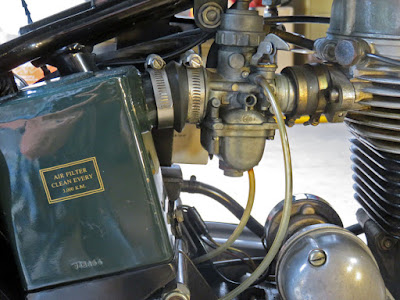 |
| Carburetor nearly knocked out of hose to motor, right. |
Your Royal Enfield Bullet won't start? Check to see if the carburetor has fallen off.
Or, more accurately, been blown off.
Let me explain. I ducked into the garage Monday all suited up and ready to ride my 1999 Royal Enfield Bullet. I was pretty confident. It had run perfectly on our previous outing only a few days before, and I had plenty of gas.
My first kick, though, brought a powerful kick back from the motor. That happens sometimes. Just clearing its throat, I figured. I was surprised when the second and third kicks brought more kickbacks. Each one was more mild than the one before.
And then: nothing, no matter how much I kicked. Not even a kickback anymore.
I went through my starting drill carefully. No good. I changed the spark plug. Nothing. With time for a ride running short I rolled the motorcycle back into the garage.
A motorcycle only needs three things to start they say: Compression (I could feel that through the kick starter lever). Fuel (I thought I had that). And Ignition.
There's an old saying that most fuel problems are electrical problems.
"It's always the electrical system," runs an old saw.
So Tuesday I started with that, cleaning and adjusting the points even though they were fine to start with. I experimented with different spark plug gaps. I experimentally advanced and then retarded the ignition timing.
No joy.
So, Wednesday, I decided I would have to consider a new battery.
My multimeter is a cheap Radio Shack device my dad gave me when I was in Junior High School, 55 years ago. I don't trust it and, in fact, internal corrosion finally dealt it a death blow this time. But before that happened I managed to get identical readings from the motorcycle battery and the battery of my car. So the battery (relatively new) was probably still good.
Thursday, I decided I would tackle the fuel system. Maybe, I thought, I could rap on the side of the carburetor to free the floats, assuming they were stuck.
 |
| Backed out and off kilter, carb let lots of air enter motor. |
But wait. As I tapped the carburetor with the hilt of a screwdriver, something struck me as odd.
I knew I had my answer: the carburetor was coming off the motor, leaving an opening that undoubtedly drew in more air than fuel. The motorcycle wasn't going to start in this condition.
But with the carburetor back in place, the motorcycle started right up. No kickback either.
Did the original kickbacks knock the carb back off its inlet fitting? Or had it already fallen loose, causing the kickbacks with an over-lean mixture?
I don't know. But add examining the carburetor to the list of a hundred things I'll check next time my Bullet gets too grumpy to start.
 |
| Air filter box leaning way left should have been the tip-off. |
































Your rubber fittings in these photos and most likely those gaskets are way past their "best used by" date. Go to Hitchcocks and get replacement parts now. Replacement gas lines you can pick up at any small engine repair store.
ReplyDeleteGood advice. I will say, though, that the main article here, the hose between the motor and the carb, is a hulking thick section cut from radiator hose, a real beast that shows no sign of wear. The metal bands holding it needed tightening.
DeleteA 1 3/8" piece of fiber reinforced 1 1/4" diameter radiator hose and two 1 1/2" stainless hose clamps put paid to this issue. The standard metal band clamps are insufficient. None of my OEM rubber bits lasted more than 4-6 months in service, some even died on the shelf.
DeleteRadiator hose is stiffer and stops the sagging off of the OEM set up. This allows you to run a clamp-on oiled gauze filter, which filters better than the standard air box. Saves about 5 pounds of iron and much simpler to service. Oiled gauze is relatively water resistant, at least for conditions I'm willing to ride in.
"ChennaiWrencher" has already tipped you to the radiator hose fix. Sometimes an air leak issue is not so immediately apparent as the carb dangling off, so another quickie diagnostic test for air leaks at or around the intake manifold in cases of "rough running" is to start the bike, let it idle, and "spot spray" a little WD-40, carb cleaner, starting fluid, or similar around the carb and manifold. Those little red plastic hose doodads the sprays come with really help target the spray. If you spray a certain spot and the engine idle increases, you've found an air leak.
ReplyDelete